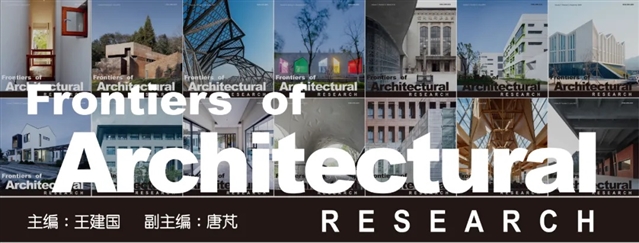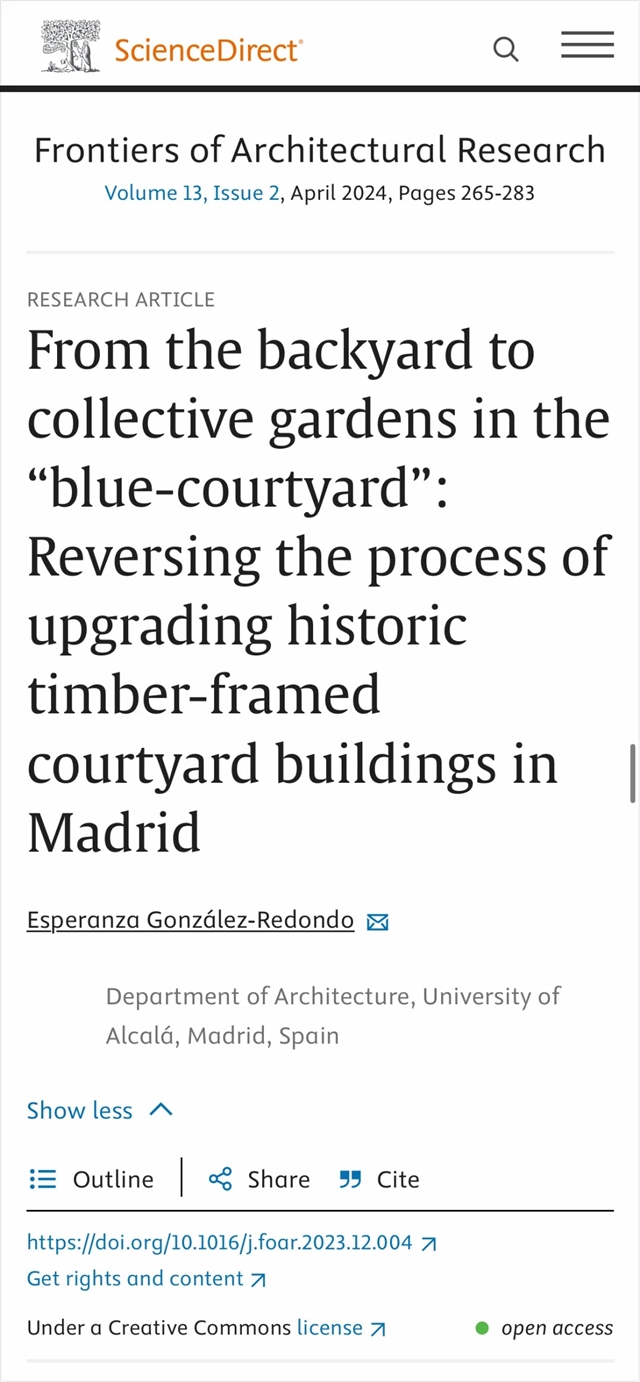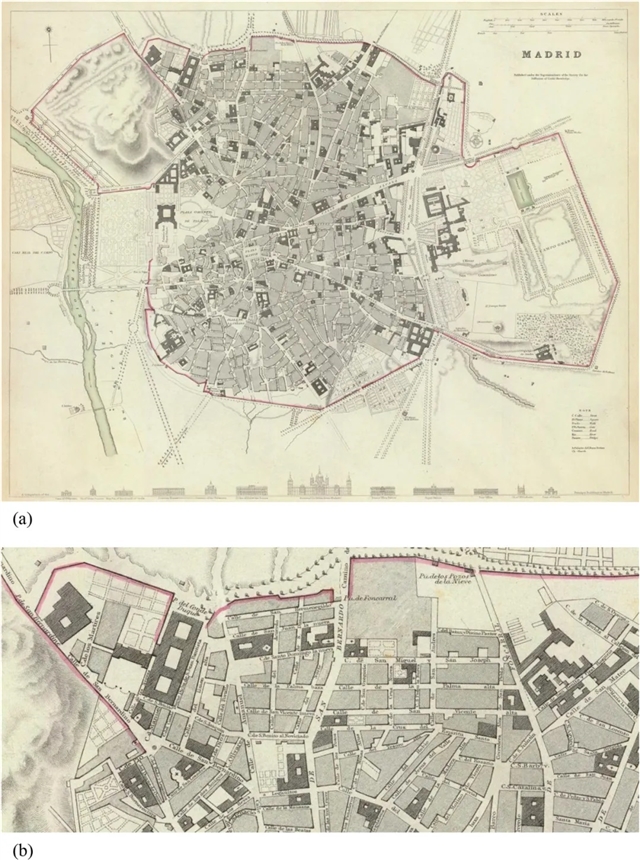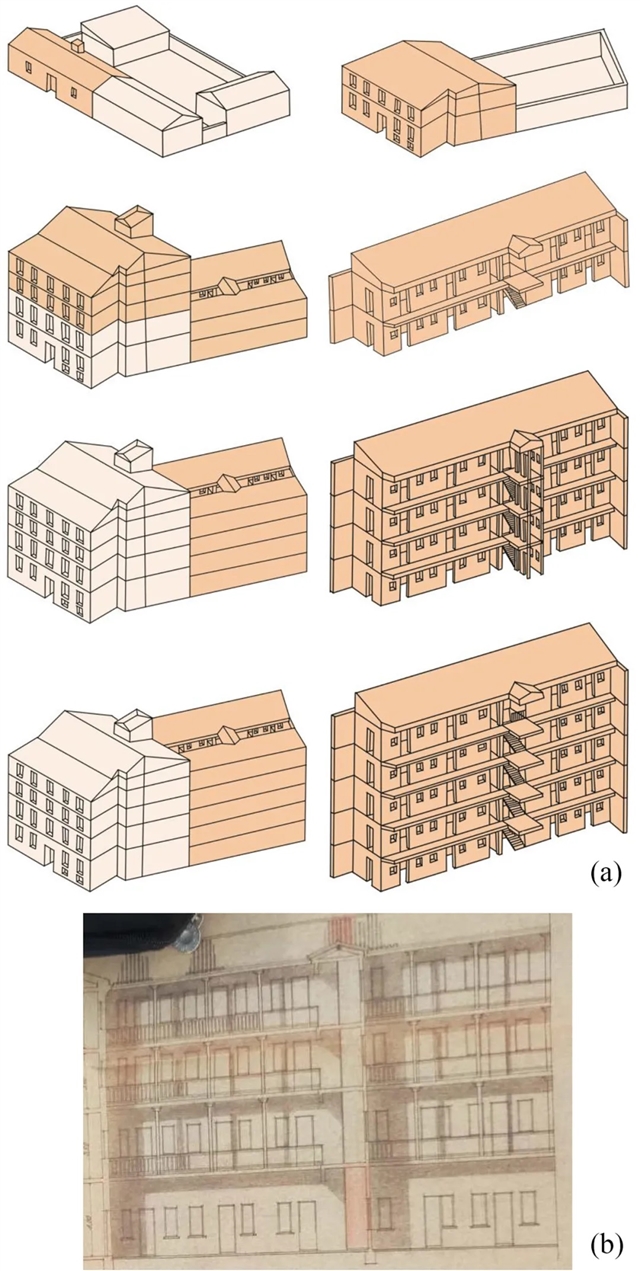|
|
|
|
|
FoAR 从后院到“蓝色庭院”中的集体花园:逆转马德里历史性木结构庭院建筑的升级进程 |
|
|
论文标题:From the backyard to collective gardens in the “blue-courtyard”: Reversing the process of upgrading historic timber-framed courtyard buildings in Madrid
期刊:Frontiers of Architectural Research
作者:Esperanza González-Redondo
发表时间:23 Apr 2024
DOI: 10.1016/j.foar.2023.12.004

FoAR是由高等教育出版社和东南大学建筑学院联合主办的全英文学术期刊
建筑学 / 城乡规划 / 风景园林
本刊已被 A&HCI / CSCD / Scopus / DOAJ / CSTPCD 收录
Frontiers of Architectural Research(建筑学研究前沿/FoAR)于4月初在线发布了2024年第二期,共12篇文章。本期推送为其中一篇文章的摘要和大纲,内容采用中文表达,方便大家阅读。推文内容不可直接引用。感兴趣的读者,请点击文末左下方“阅读原文“,可免费浏览及下载原版英文论文。


From the backyard to collective gardens in the “blue-courtyard”: Reversing the process of upgrading historic timber-framed courtyard buildings in Madrid
从后院到“蓝色庭院”中的集体花园:逆转马德里历史性木结构庭院建筑的升级进程

Esperanza González-Redondo
Department of Architecture, University of Alcala ?, Madrid, Spain

This paper presents an analytical framework for evaluating the impact of the two main processes identified in Madrid timber-framed courtyard buildings reinforcing the court- yard’s crucial role in architectural heritage sustainability: their development caused dwellings to darken (1737-1950), and the existing challenge is to open new patios according to the listed buildings’ protection policy.
Critical findings in archival research and existing building assessments led to completed data collection and analysis. When exploring construction expansion, from the house towards the collective prototype around a gradually reduced patio and dwelling darkening (1737-1786), buildings resulted in open, semiopen, underlighted and closed designs. Study area on-site assessment uncovered the transition from the older low-rise type (1-3) floors to the modern closed model of up to (4-6) storeys.
Construction enlargements, consequently reducing original green areas and courtyards, call for reversing that process or formulating a new strategy. It debates the partial demolition of listed buildings in upgrades and its agreement with the needed “blue courtyard” strategy (PGOUM), resulting from joining new rear individual patios to create a communal building block courtyard. The uncovered “in-between” type (1864), which integrates two open-air collective spaces, an inner courtyard and a back garden, appears challenging to explore.
本文提出一种分析框架来评估马德里木构庭院建筑中的两个主要营造过程对建筑遗产可持续性的影响:在1737至1950年期间,庭院的减少导致了住宅采光变暗,现有的挑战是根据列出的建筑保护政策规定,需要开辟新的庭院。
通过档案研究和现有建筑评估的关键发现,我们完成了数据收集和分析。当探究扩展时,从房屋到集体原型(周围庭院逐渐减少)再到室内采光逐渐变暗(1737-1786),建筑物形成了开放式、半开放式、低照度和封闭式设计。现场评估研究区域,揭示了从旧的低楼层类型(1-3层)到现代封闭模型(4-6层)的过渡。
建筑扩大,减少了原有的绿地和庭院,需要扭转这一过程或制定新的方案。本文反对在建筑升级中将目标建筑进行部分拆除,并对必要的“蓝色庭院”方案(《马德里城市发展总体规划》,通过在后方加设独立天井来创建一个公共建筑庭院)表示支持。而本文发现的“中间”类型(1864),将两处露天的集体空间,即内庭院和后花园,整合在一起,似乎在研究上具有挑战性。

Courtyard / 庭院
Sustainable design / 可持续设计
Architectural heritage / 建筑遗产
Archives / 档案
Timber-framed construction / 木构建造
Social housing / 廉租房

1. Introduction / 引言
2. Literature review and research aims / 文献综述与研究目标
3. Research methodology and data collection / 研究方法与数据收集
3.1. Identifying the two processes and the underlying parameters / 确定两个过程及基本参数
3.2. Data collection and analysis framework strategies / 数据收集与分析
3.3. Darkening process analysis and results / 采光变暗的分析与成果
3.4. Reversing the process strategy / 逆转过程策略
4. Findings approach / 研究方法
4.1. Archival research collecting old data / 档案旧数据收集研究
4.2. Determining the study model / 确定研究模型
4.2.1. Building the inner courtyard / 建造内庭院
4.2.2. The study parameters / 研究参数
4.3. Identifying the old building types / 确定旧建筑类型
4.3.1. Outer boundaries and types / 外部边界与类型
4.3.2. Inner boundaries and built-up areas / 内部边界与建成区域
4.3.3. Dwellings and shared facilities / 住宅与公用设施
5. Results / 研究成果
5.1. Prototype evolution towards new dark spaces / 原型进化为新型暗空间
5.1.1. The original old models’ lighting / 原始旧模型的照明
5.1.2. The enlargements: rear extension and new floors / 扩建部分:后部扩建与新楼层
5.2. New findings / 新的发现
5.2.1. The “in between” timber-framed courtyard building / “中间过渡”木构庭院建筑
5.2.2. Prototype and adaptations / 原型与改造
5.2.3. Dwelling development to upgrade housing / 住宅发展提升房屋质量
6. Discussion / 探讨
6.1. Building survey / 建筑调查
6.1.1. Study area and selection criteria / 研究范围与选择标准
6.1.2. Determination of construction phases (I-VI) / 建造阶段的确定(1-6级)
6.1.3. The fully extended floor plan configuration / 充分扩展的平面布局
6.1.4. From a low density of 1-3 floors to closed models of up to 4-6 floors / 从低密度的1-3层上升至4-6层的封闭模型
6.2. Reversing the process framework / 过程框架的反转
6.2.1. From the private garden to the shared inner courtyard / 从私人花园到共享内庭院
6.2.2. Towards green shared back areas / 走向绿色共享的后部区域
6.3. Conservation and rehabilitation challenges / 建筑保护与修缮中的挑战
6.3.1. The “blue courtyard” as a collective transformation (PGOUM, 1997) / “蓝色庭院”(1997年《马德里城市发展总体规划》)
6.3.2. The “in-between model” adaptation: a challenge to explore / “过渡模型”的适应:研究探索中的挑战
7. Conclusion / 结论


▲ 图一:(图a)1622年至1868年,第四道城墙内的马德里历史中心(Clarke, 1831年)。(图b)北郊地区。 © 本文作者

▲ 图二:From the garden to the inner courtyard in the northern suburb area next to the wall (1656-1874): (a) Houses with back gardens (Texeira, 1656). (b) Extension of high-rise buildings with an interior courtyard (Iba ?n ?ez Ibero, 1872-1874); in purple, those preserved with a patio and in blue, those also having a timber framed gallery。

▲ 图三:(a) Old models’ floor plans: a. House (Magdalena St.); b. Open (San Vicente-AVM.1-45-140, 1759); c. Semiopen (Limo ?n- AVM:1-46-8, 1767); d. Underlighted (Greda-AVM:1-84-106, 1748); and e. Closed model (Magdalena-AHP:16430, 1737). (b) Simplified edge analysis of old model (1e3) floors (Gonza ?lez-Redondo, 2023)。

▲ 图四:(a) Elevations according to archival evidence (AVM) below: n 13 (1761); n 15 (1784); n 17 (1656); n 19 (1790); n 21 (1797) and n23 (1789); and above, approach to current elevations. (b) Buildings in block n472 analysed. (c) Courtyards in n13, n19, and n21 in Tesoro Street (PGOUM, 1997).

▲ 图五:(a) Construction phases on 19 Tesoro Street (Fayos and Gonza ?lez-Redondo, 2023); and (b) archival data (AVM- 1950).

▲ 图六:(a) Building block no472 development (1656-2023). (b) The shared blue courtyard needed in the PGOUM; and (c) reversing the process: a communal patio inside the block.


Esperanza González-Redondo
Professor
Department of Architecture
University of Alcala ?, Madrid, Spain
Research field: the construction analysis of historical timber-framed buildings with a particular interest in the study of the Historic Centre of Madrid, from the oldest timbered constructions to the transition to new iron structures (1494-1900).


长按上方二维码|浏览本期精彩论文
▼ 点击下方词条 | 往期精彩不容错过
#期刊快讯#系列
1/ 主编王建国院士团队荣获国家科技进步奖一等奖
2/ FoAR|2021年度报告,2022新年快乐!
3/ FoAR|2022年度报告,2023新年快乐!
4/ FoAR|2023年度报告,2024新年快乐!
5/ 最新|FoAR 2022 CiteScore 指数上升为4.7
6/ 2022年度JCR发布|FoAR 首获影响因子 3.5,位列建筑领域期刊第一
7/ 最新|FoAR 被中国科技论文与引文数据库(CSTPCD)收录
8/ 最新|FoAR 再次入选中国国际影响力优秀学术期刊
9/ 最新|FoAR 荣获科爱十大优秀期刊奖
10/ 最新|FoAR进入2023年中科院分区表1区
#新刊上线#系列
2024年第一期
2024年第二期
#FoAR投稿指南#系列
1/ 投稿流程
2/ Guide for Author中文版
3/ 审稿流程及发表流程
4/ 如何提交修改稿
5/ 录用文章出版流程
#期刊知识科普#系列
1/ SCI之父尤金·加菲尔德的传奇人生
2/ 国际核心期刊数据库大解析
3/ 手把手教你如何使用最强工具Web of Science
4/ 如何发现一本好期刊
5/ 国内核心期刊有哪些
6/ 版面费与期刊影响力
#精彩文章#系列精选
01/ 城市设计实践发展的多元维度——基于UAL的案例研究
02/ 从智慧城市到共情城市
03/ 传统阿拉伯伊斯兰城市居住区形态学:以传统城市大马士革为例
04/ 建筑遗产预防性保护的意大利视角
05/ 生物与建筑:将科学知识与设计实践相结合的六家法国建筑事务所项目案例研究
06/ 颇具争议的渐进式改造:Elemental建筑事务所金塔蒙罗伊公屋居住区项目的15年
07/ 联合眼动实验和SD法的传统商业街区视觉效果感知评价
08/ 历史的层次:古城堡遗迹中的新建筑改造
09/ 通过空间句法检验帕拉第奥别墅平面中的控制性、中心性和灵活性
10/ 自1931年柯布西耶的Salubra色卡问世后其建筑色彩的偏好:一种跨文化的分析
11/ 建筑师身份的描绘:1920年代末的中国美术建筑师——刘既漂
12/ 探索暴露于风影响下织物的表达与功能
13/ 绿色屋顶能否在地中海气候条件下显著节约能源?基于不同案例的批判性评估
14/ 芬兰近期落成的原木建筑的建构及建筑品质:相关建筑师的解读
15/ 新加坡高校教室光环境品质研究

《前沿》系列英文学术期刊
由教育部主管、高等教育出版社主办的《前沿》(Frontiers)系列英文学术期刊,于2006年正式创刊,以网络版和印刷版向全球发行。系列期刊包括基础科学、生命科学、工程技术和人文社会科学四个主题,是我国覆盖学科最广泛的英文学术期刊群,其中12种被SCI收录,其他也被A&HCI、Ei、MEDLINE或相应学科国际权威检索系统收录,具有一定的国际学术影响力。系列期刊采用在线优先出版方式,保证文章以最快速度发表。
中国学术前沿期刊网
http://journal.hep.com.cn

特别声明:本文转载仅仅是出于传播信息的需要,并不意味着代表本网站观点或证实其内容的真实性;如其他媒体、网站或个人从本网站转载使用,须保留本网站注明的“来源”,并自负版权等法律责任;作者如果不希望被转载或者联系转载稿费等事宜,请与我们接洽。